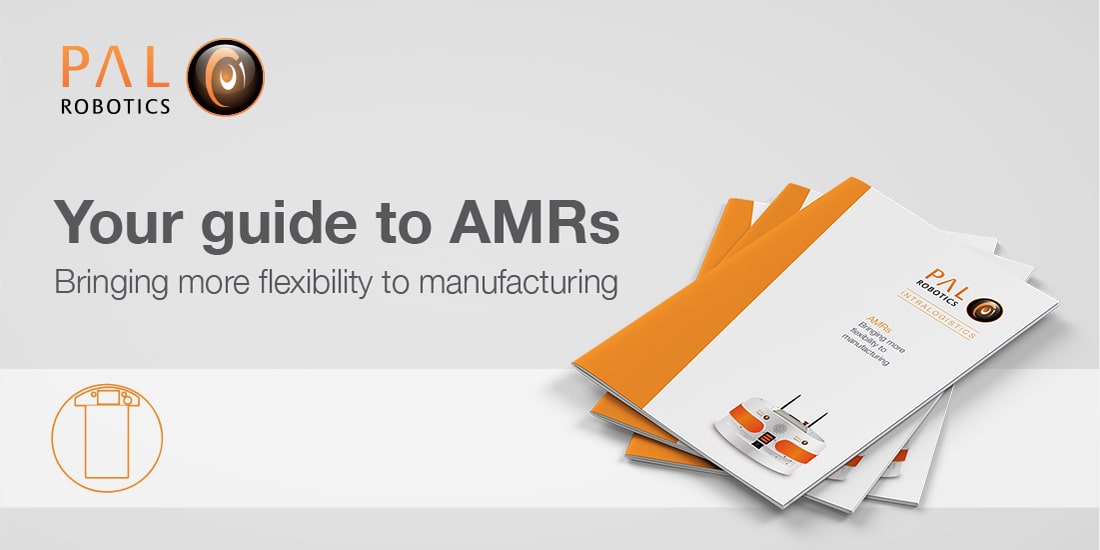A number of developments in transportation of goods in industry have been transforming operations in recent years. Autonomous mobile robots (AMRs) are one of these. AMRs are Mobile Robots that navigate autonomously by being able to identify and map their surrounding area independently.
AMRs connect to continuing advances in robotics including increasing Human-robot collaboration. Product development today focuses on methods to enable robots to respond in real-time; to be able to adjust their motions to their environment for a true responsive collaboration.
AMRs challenge some of the roles which have in the past been filled by Automated Guided Vehicles (AGVs) which work along fixed routes only. AGVs take time to establish, and can be more expensive to set up, yet once they are in place they help contribute to a set production output. However, the development of AMRs brings with it the chance to do things differently. The choice for the organization between whether to implement AMRs, AGVs, or a combination of both, depends on both their production processes and requirements.
AGVs versus AMRs
We’ve identified some of the key differences in navigation, responsiveness, accessibility and production between AMRs and AGVs.
Navigation
- The way AMRs and AGVs navigate demonstrates how they operate. AMRs are more responsive and flexible, and are able to adapt to changes in the factory layout and carry out new operations without requiring major changes in their environment, or significant resources, time or or financial investment. AGVs’ adaptability is limited because they are normally deployed to accomplish one mission, so if the company needs to change production, modifying them can be expensive.
Responsiveness and flexibility
- AGVs are limited to being able to perform the same task, whereas AMRs can perform broadert tasks.
- When navigating, AMRs are able to recognize and avoid obstacles in order to safely find their way to their destination. AGVs will not be able to smartly re-adjust their path when encountering obstacles and sometimes require human intervention to re-start.
- AGVs typically weigh more than 150kg, whereas AMRs usually weigh between 40 and 60kg.
Accessibility
- AGVs require significant installation and training before use, whereas AMRs can be used by workers with no previous robotics knowledge or experience.
Production lines
- AMRs’ tasks can be easily changed, in order to work within Agile production lines.
- AGVs are programmed to perform set tasks, so changing these is a much more extensive project.
Adopting Autonomous mobile robots (AMRs)
AMRs have many benefits for organizations, however implementing them into a manufacturing environment does bring with it some challenges. Most of these challenges are related to finding the right AMR structure and customization to meet company needs. As is the case when adapting any new technology to an industrial environment, clear expectations and goals should be set in order to maximise effectiveness and ROI.
Safety in the workplace is always a priority. In this sense, Autonomous Mobil Robots are a major advantage because they are able to carry out tasks that can be time consuming, repetitive, dull, and dangerous, freeing up workers to dedicate time to more valuable and complex tasks, and contribute to higher levels of safety in the work environment.
AMR use case: a car manufacturing plant
AMRs are bringing more flexibility into manufacturing. A recent example of a successful AMR use case is at a car manufacturing company near Barcelona, Spain. The company successfully incorporated PAL Robotics’ AMR platform into their powertrain plant in 2019.
This project was implemented by the company to use robots for delivery of transmission parts. The organisation wanted to improve their assembly/quality/production line, in order to reduce their operational costs. For the company, this technology was introduced in a complex environment, where the robots moved around fully autonomously sharing the environment with people and other vehicles (forklifts, AGV and manual carts).
Provided by PAL Robotics

